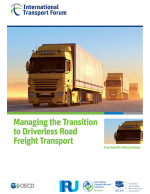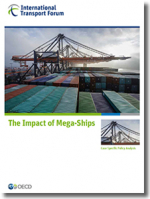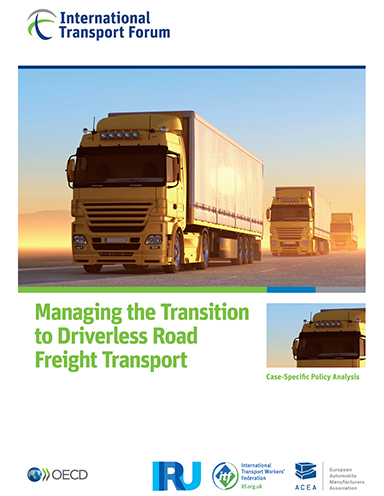Managing the Transition to Driverless Road Freight Transportation
This report sets out the findings of an ITF project on managing the transition to driverless road freight transport, directed by José Viegas and managed by Daniel Veryard.
Managing the Transition to Driverless Road Freight Transport
This report considers how a transition to driverless road freight transport could happen.
Today’s technology already makes it possible to operate automated trucks.
Reduced reliance on humans to move road freight in the future could offer large cost savings for businesses and consumers.
It could also disrupt the careers and lives of millions of professional truck drivers.
Based on different scenarios for the large-scale introduction of automated road freight transport, this study makes recommendations to help governments manage potential disruption and ensure a just transition for affected drivers.
Three leading transport-sector organisations joined the International Transport Forum for this study to assess the benefits, costs, and risks of driverless trucks.
The International Road Transport Unions, the International Transport Workers’ Federation, and the European Automobile Manufacturers Association contributed data and insights on driverless technology in the road freight sector as well as funds for the research.
What We Found
Driverless trucks could be a regular presence on many roads within the next ten years. Self-driving trucks already operate in controlled environments like ports or mines, and trials on public roads are underway in many regions including the United States and the European Union.
Manufacturers are investing heavily in truck-automation technology while many governments are actively reviewing their regulations to understand what changes would be required to allow self-driving vehicles on public roads. Automated trucks would enable cost savings, lower emissions, and safer roads. They could also address the emerging shortage of professional drivers faced by the haulage industry, particularly in Europe.
Without driverless trucks, around 6.4 million truck drivers are projected to be needed across Europe and the United States (US) by 2030, yet fewer than 5.6 million are projected to be available and willing to work under current conditions. The majority of truckers are in the later stages of their careers, while few women and young men are choosing trucking as a profession.
The adoption of driverless trucks is likely to reduce demand for drivers at a faster rate than a supply shortage would emerge. Of the 6.4 million driver jobs in 2030, between 3.4 and 4.4 million would become redundant if driverless trucks are deployed quickly. Even accounting for prospective truck drivers being progressively dissuaded by the advent of driverless technology, over 2 million drivers across the US and Europe could be directly displaced by 2030 in some of the scenarios examined for this study.
What’s Related



Favorites





